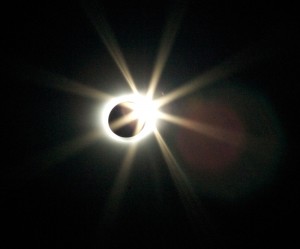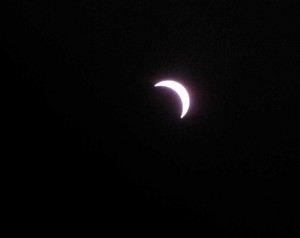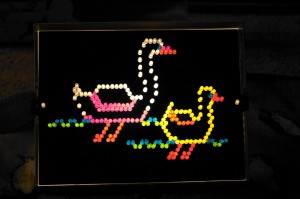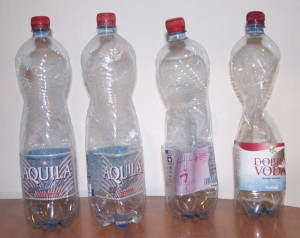The eclipse is past, it was a success, and the folks on board are ready to party. Fortunately it’s still practically deserted here in the aft lounge on deck 9, tucked away behind the casino. The pianist has been joined by a trumpet player who is quite obviously not on the payroll but what he lacks in prowess he makes up for with a sweet tone and a good attitude. Everyone seems jolly this evening. We saw a total solar eclipse together today.
I woke up early, but not as early as I had planned. Outside our porthole the sun shone brightly over calm seas. By gum, it looked like it would be a good eclipse-watching day.

Astronomy buffs prepare for the upcoming eclipse as the boat passes Iwo Jima
My plan called for breakfast first, a big meal in case the excitement later took precedence over meals. When I got up on deck, I changed my plans. Pictures first. On the port side was Iwo Jima, about as close as tourists can get to it these days. It is hallowed ground, dedicated to the memory of the blood shed over a few square miles of rock in the middle of the ocean. I thought about the marines who had looked over the waves at the same island so long ago, knowing that soon they would step ashore there. I took a couple of pictures in cooperation with Stereoptic Pete, who I have not mentioned yet in these chronicles, but I’ll get to that another day.
The island behind us, we set course for the center of the path the eclipse would take, balancing the longest possible totality with the occasional banks of clouds. “We’re good for Plan A,” the organizer said over the ship’s PA system. I went for breakfast and to make sure that I was as ready as possible for the main event. memory chip cleared, battery (and backup) fully charged, no funky settings on the camera. I went over in my head what I would do for the six and a half minutes of totality. 1) Look at eclipse 2) take pictures of eclipse. I reminded myself to get the priorities right. There would be plenty of pictures to share among the family, but there won’t be another eclipse as long as this one for more than a century.
Also, before I took my position on the sunny deck, I needed better sun protection. My hopes of finding a decent sun hat were thwarted, but the gift shop on board had baseball caps, and one of those would be better than nothing. I sprang for the hat, slathered on the sunscreen, and headed topside.

Sun goggles on! Sunscreen on! Hat on (for now)!
I took up a position on the patio at the stern of deck 10. It was less crowded (most of the patio is covered by an awning) and it was close to the beer. It also had the benefit of having a good view to the rear, and I hoped to see the cone of the shadow overtake us as second contact approached.
It wasn’t long before first contact – the moment when the disk of the moon first impinges on the sun. I pulled out my sun-looking-at shades and watched. Near me was a German couple and their cute-as-a-button daughter. The eclipse was going a bit slowly for a girl her age, so I took the daily newsletter, unfolded it, and punched a pattern of holes into it with my pen, creating the largest array of cameras on the boat. We had a good time looking at the dozens of crescent shapes projected onto the table top, projecting them on each other, and generally goofing around.
The day grew dimmer, and cooler. The ship adjusted course to run right down the center of the track, prolonging the totality by a fraction of a second. (“Because we can,” the director explained.) Unfortunately, due to poor math on my part, I had positioned myself directly under the ship’s exhaust on our new heading. As the deck became crowded with the ship’s crew, I crossed over to the other side of the boat, pausing to get a beer on the way. I found a spot on the rail, introduced myself to my new neighbors, and made another check of the camera. I was shooting with a big ol’ zoom lens and it seemed like about halfway zoomed would give the best results. I checked ISO, focus, shutter speed, and aperture. I was ready. The plan was to not spend too much time thinking, but just step through a whole bunch of settings, assuming at least one would give good results.

Second contact, the photo shaken as I grabbed in futility for my runaway hat.
The cone of darkness appeared behind us as the world dimmed. The temperature, cooling steadily for the last hour, dropped abruptly further. The light took on an odd twilight aspect. I looked up, and saw the last flare of the sun vanish behind the rugged lunar terrain. Second contact, they call that moment in the biz. I raised my camera, almost vertical, and lined up my first shot. Shoonk went the slider for the zoom, pulling me back from the image. Fwip went my brand-new hat as it tumbled off my head, over the rail, and into the sea far below. I took the picture.
You’ve seen eclipse pictures before, better ones than these. Probably you’re read descriptions of the time spent in the shadow of the moon. Twilight in the middle of the day. Sunset-pink clouds on the entire horizon, 360 degrees. All I can add is “spooky”. Venus appeared, then elusive Mercury and some of the brighter stars. The whispy streamers of the corona cast an eery glow over the sea, and the sky was a color I’d never seen before.
I raised my beer to sun and moon and corona and speedy little Mercury and I silently toasted the spectacle.

The inner corona of the sun, with streamers and stuff
I took some more pictures, pausing now and then to take it all in, not thinking about anything but the thing itself. Well over six minutes passed that way, then came the first peek of the sun through a valley on the lunar surface, a flash known as the diamond ring that means that we have reached third contact and the magic is coming to an end. I quickly made an adjustment to the camera and fired up at the emerging brightness. And waited as my camera beeped off ten agonizing seconds before taking the picture. It turns out I had adjusted two things. Maybe I was lucky, however; the picture came out right nice.
I hadn’t taken any shots of the crescent sun before totality, but afterwards I found a piece of solar filter blowing across the deck and held it over the lens with one hand while shooting with the other.

The "diamond ring" as the sun peeks through a valley on the moon, while the corona is still visible.
Eventually it was time to abandon my post and find the rest of my group, in the more crowded areas forward of my position. “Did you get good pictures?” people asked as I moved around. “I don’t know,” I said. I hadn’t gone back to look at them. It didn’t even occur to me until later. I was pretty sure that I was moving the camera too much anyway.
Before fourth contact, while the moon was still slinking back into obscurity, the moon geeks began to break down their fancy telescopes and clever moon-watching devices and the party atmosphere began. The ship hoisted the official ‘successful eclipse’ flag and cheering ensued. Our boat shared horn blasts with other boats that had come to the ideal viewing spot. My cousin sweet-talked the head of bartenders on the boat to slide me a free Eclipse Cocktail.
The central lounge on the boat was packed this afternoon, filled with clusters of people (like us) reliving the experience, checking photos, and partitipating in the traditional cruise activities for the first time in days.

As the eclipse geeks below begin to celebrate, the moon slowly moves along.
Tonight after dinner (celebrating fuego’s mother-in-law’s birthday) I followed my nephew out to the foredeck, kept dark for this cruise only, to allow people a place to see the stars. There was the Milky Way and a buttload of stars, along with the fiery trail of the occasional meteor. I stayed out there for quite a while in the dark and quiet, listening to the low conversations around me and thinking about how big it all is, this universe measured in time, and how tiny was the little island we had passed that morning.
Sun and Moon collide
bound by ancient formulae
meteors are free
 1
1
Sharing improves humanity:









